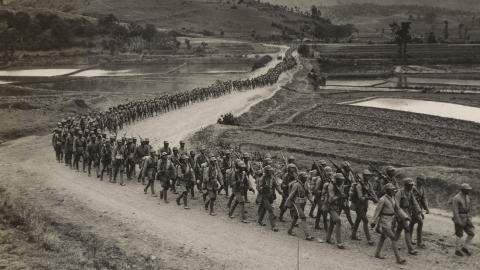Battlefields of Belgium
Belgium hasn't had a lot of luck when it comes to European wars during the last two hundred years. The country is closer in size to Wales than England and has only one-eighth the population of Germany, but, hemmed in as it is on all sides by the historically warring nations of France, Germany and Britain, its location gives it crucial tactical importance. Now known more for its famous battlefields than its frites, Belgium's fertile fields played a decisive role in the Napoleonic Wars, World War 1 and World War 2.
The Battle of Waterloo, staged about 13 kilometres south of Brussels, ended Napoleon's bid for European domination in 1815. The French forces met an army composed of British, Prussian, Belgian and Dutch troops led by the Duke of Wellington on the 18th of June, with Napoleon relying on his wits and superior firepower and Wellington on his tried and true strategic and tactical judgement. While Napoleon's goal was to destroy the Allied army once and for all, Wellington only had to hold his position until Prussian reinforcements arrived (in the form of an army that Napoleon thought, erroneously, he'd already defeated). Unfortunately for Napoleon, his usually brilliant military mind failed him, and Wellington – with the help of elderly Prussian commander Gebhard Leberecht von Blücher – not only won the battle, but ended both the Napoleonic Wars and Napoleon's Hundred Days' reign.
Fascinating fact: Wellington named the Battle of Waterloo after the village in which he spent the night preceding the fight.
Ninety-nine years later, the same players would meet in Belgium once again, but in a different war and on opposite sides. In WW1, Germany used the Schlieffen Plan as their main deployment strategy, which recommended the majority of the German army march through Belgium to Paris. This time, the French, British and Belgians were allies fighting against the former Prussian, now allied German, army. WW1's first clash happened at Mons, and the Germans ran into two obstacles: significant resistance from the Belgian Army, and the British Expeditionary Force's lightning-quick (in those days, at least) mobilisation. This resulted in Allied and German forces being bogged down in a war of attrition in the Ypres salient, at the town of Ypres in West Flanders, from the beginning of the war until its bitter end. Many of the Western Front's bloodiest battles were fought in and around the Ypres salient, including First, Second and Third Ypres, Langemarck and Messines.
Fascinating fact: In 1914, the British soldiers at Ypres had no idea how to pronounce the name of the town they fought near, so they called it 'Wipers'. Hence the name of that famous trench newspaper, The Wipers Times.
The more things change, the more they stay the same. In December 1944, the same Allied forces (this time with added Americans) met the same antagonist in Belgium to fight in WW2. The Battle of the Bulge, in Ardennes, turned out to be one of the nastiest battles of the war, and certainly the most costly for the American forces, which had more than 600,000 men in the fray and suffered an estimated 15 per cent casualty rate. But it was this battle that finally depleted German reserves and wiped out the Luftwaffe, signalling the beginning of the end for Germany.
Fascinating fact: Due to the loss of manpower at the Battle of the Bulge, black Americans serving in the army were officially integrated into front line service for the first time.
















